Cascadia Research will be undertaking a 10-day field project off the island of Kaua‘i starting February 1st, 2014, working in conjunction with researchers from HDR Inc., and the Naval Facilities Engineering Command Pacific as part of the Navy’s monitoring program. This will be our 10th field project (and 7th year) working off Kaua‘i and Ni‘ihau. The primary purpose of the project is to obtain information on movements and habitat use of a number of species of toothed whales through the deployment of satellite tags. We are also hoping to examine movements of animals before, during, and after a Submarine Commanders Course being undertaken by the U.S. Navy later in February.
As we do during all of our field projects, we will also be obtaining photos from most species of odontocetes we encounter, to contribute to ongoing studies of residency patterns and social organization and to estimate population sizes, and collecting biopsy samples for toxicology and genetic studies. Last year we had two similar field projects, one in February and one in July and August, and like those projects we expect to have higher encounter rates than normal since we’ll be working in collaboration with the Marine Mammal Monitoring on Navy Ranges (M3R) program, using the Navy’s hydrophone range off Kaua‘i (see map below) to localize animals. When on the water we will be in constant contact with Navy researchers from the M3R program to help direct us to groups that they are detecting acoustically. This will allow us to confirm the species (to aid in using the acoustic range for research purposes on different species), and should make it much easier for us to find groups of whales and dolphins for tagging, photo-ID and biopsy sampling.
Species that we are hoping to satellite tag include rough-toothed dolphins, bottlenose dolphins, false killer whales, short-finned pilot whales, melon-headed whales, pygmy killer whales, sperm whales, Cuvier’s beaked whales, and Blainville’s beaked whales.
The research team includes Daniel Webster, Brenda Rone, Amelia Brower, Elisa Weiss, and Robin Baird. This work is being funded by Commander, Pacific Fleet.
End up project update
Over the last 10 days we covered almost 1,300 kilometers off Kauai, and had 26 sightings of five species of odontocetes. We deployed satellite tags on four species, and are obtaining data from 10 different groups: three groups of pilot whales, two groups of bottlenose dolphins, two groups of rough-toothed dolphins, and one group of Blainville’s beaked whales. Four of the tags are depth-transmitting satellite tags, so we are also obtaining dive data from those tags.
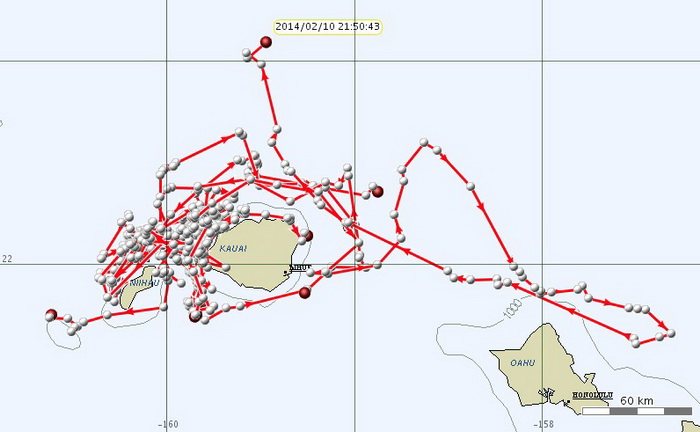
This map shows movement data from all 10 individuals over the last 10 days.
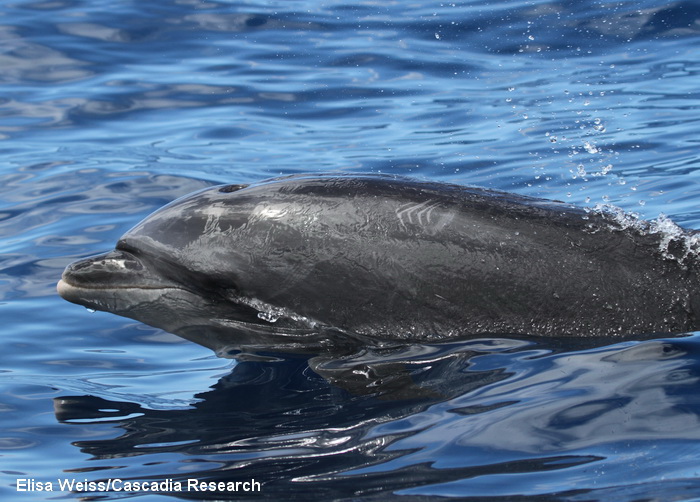
A bottlenose dolphin, February 10, 2014, photo by Elisa Weiss. On our last day on the water the winds were strong from the southeast, so we were forced to work off the north side of Kauai, where we encountered a group of about eight bottlenose dolphins, and were able to photo-identify all the individuals present.
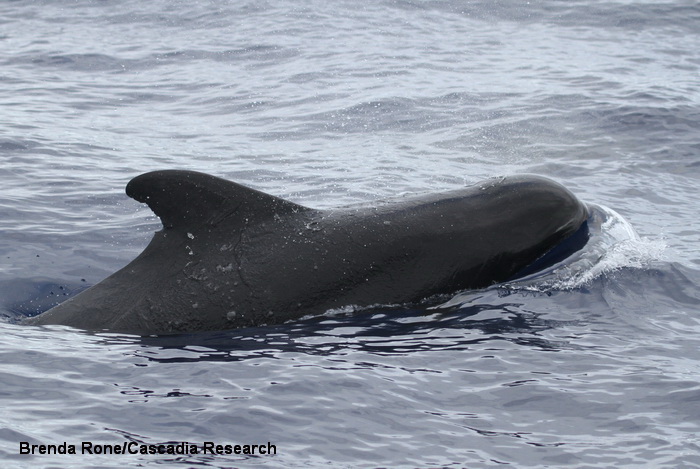
A short-finned pilot whale, February 9, 2014. Photo by Brenda Rone. On February 9th we encountered one of the groups of short-finned pilot whales we’d seen earlier in the trip and deployed two satellite-tags.
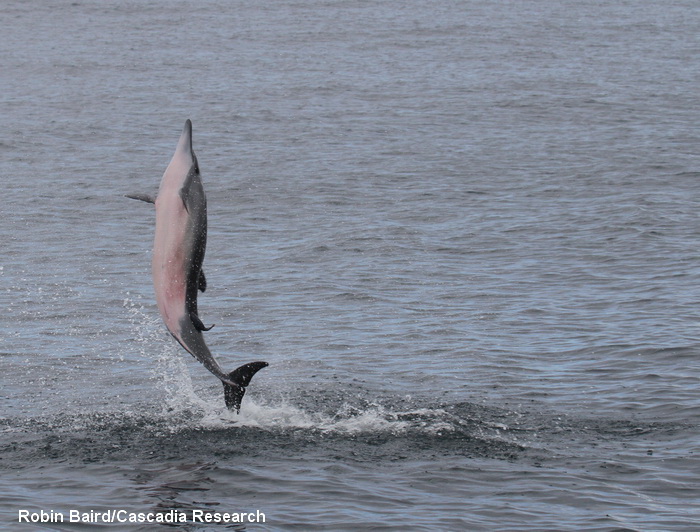
A spinner dolphin spinning to try to dislodge a remora, February 8, 2014. Photo by Robin Baird
February 6, 2014 update

Today we covered 200 kilometers of trackline off the south and southwest shores of the island, some of it in heavy rain conditions. While there were lots of humpback whales in the area, we had only two odontocete sightings, a pair of probable dwarf sperm whales, and a small group of bottlenose dolphins. Bottlenose dolphin photo by Brenda Rone, February 6, 2014.
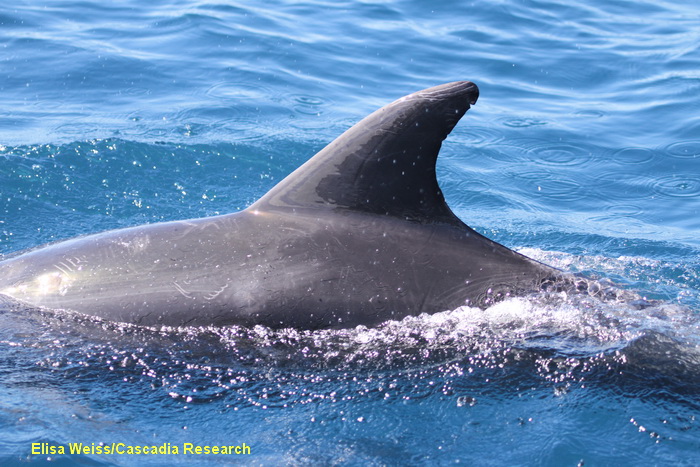
We were able to deploy a satellite tag on one bottlenose dolphin and also obtained good identification photos (photo by Elisa Weiss).
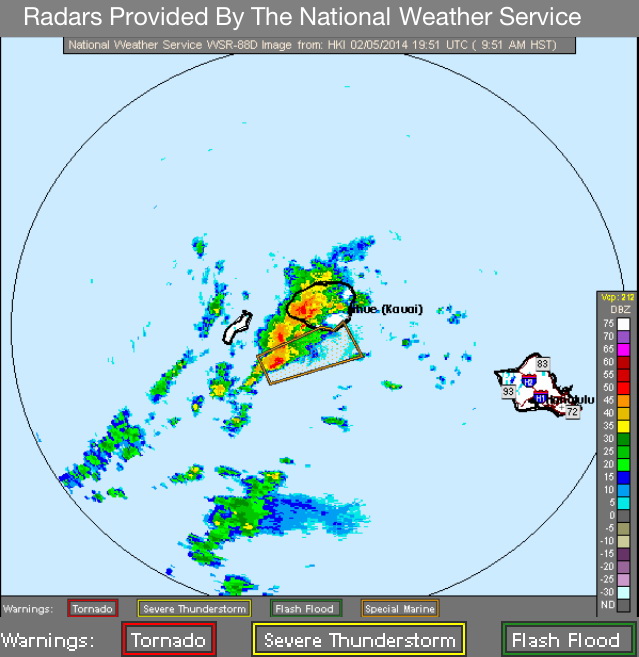
On February 5th we ventured out on the water but had to quickly turn around as a continuous series of storm cells swept over the island.
February 4, 2014 update
In our first three days on the water we had four sightings of pilot whales and one unidentified whale, probably a beaked whale. Today we added four new species to the trip list, with encounters with rough-toothed dolphins, bottlenose dolphins, spinner dolphins, and one of our highest priority species, Blainville’s beaked whales.

Adult male Blainville’s beaked whale with island of Ni‘ihau in the background. Photo by Millie Brower. We encountered a group of five Blainville’s, including an adult male, a large subadult male, one adult female and two subadults/juveniles. This was by far the most productive encounter we’ve had with beaked whales off Kaua‘i and Ni‘ihau – we were able to photo-identify all five individuals, deployed two satellite tags (one location-only and one location-dive tag, and collected one biopsy sample for genetics.

Photo-identifying a Blainville’s beaked whale, February 4, 2014. Photo by Robin Baird
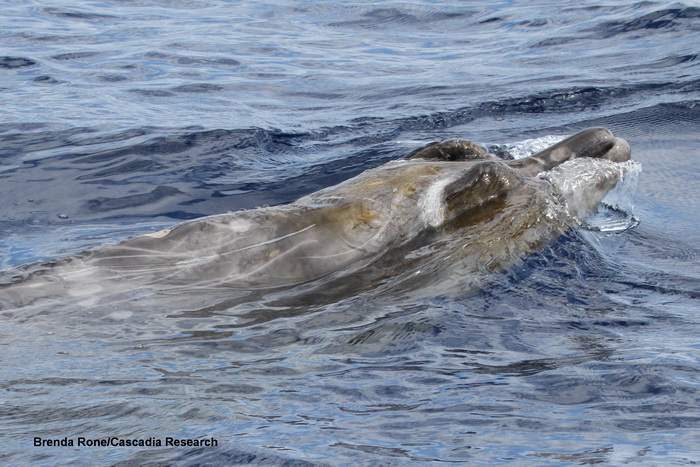
A large sub-adult male Blainville’s beaked whale, February 4, 2014. This photo shows the highly arched lower jaw but no erupted teeth are yet visible. Photo by Brenda Rone

Rough-toothed dolphin surfacing, February 4, 2014. Photo by Elisa Weiss. We encountered two different groups of rough-toothed dolphins, and were able to deploy satellite tags on one individual in each group.
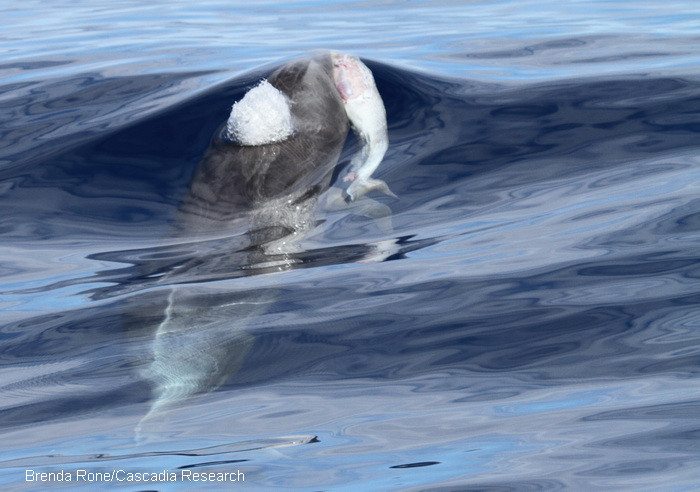
Bottlenose dolphin with fish, February 4, 2014. Photo by Brenda Rone. We encountered several groups of bottlenose dolphins and deployed a satellite tag on one individual.
February 3, 2014 update
The last two days have been quite productive, with encounters with two new groups of short-finned pilot whales. We were able to obtain identification photos of most of the individuals present, and deployed satellite tags on individuals in both groups, so that we are now obtaining movement data on three different groups of pilot whales around the island.

Short-finned pilot whale group off the southwest shore of Kaua‘i, February 3, 2014. Photo by Robin Baird

An adult male short-finned pilot whale with satellite tag immediately after tagging, February 3, 2014. Photo by Brenda Rone. The tagging arrow is visible on the right hand side after releasing from the tag. The arrow has an orange float so we can recover it. This individual was identified in our catalog as HIGm1464, seen off O‘ahu in 2004, 2009, and 2012.
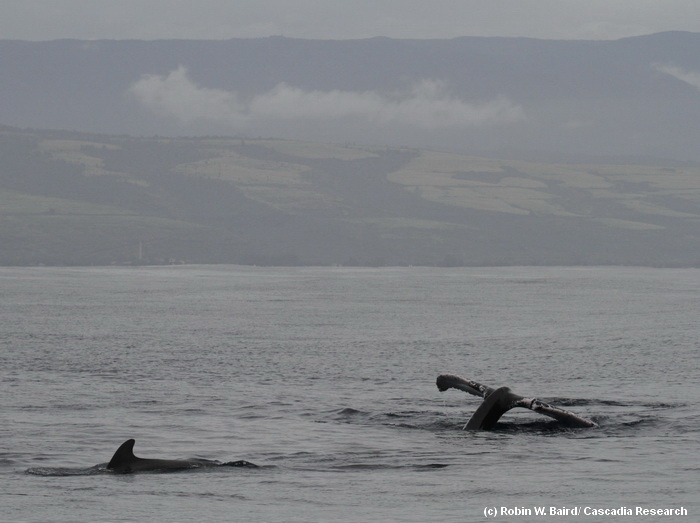
Short-finned pilot whale and humpback whale, February 3, 2014. Photo by Robin Baird. On February 3rd we re-encountered the group we had seen (and tagged) on February 2nd – during the encounter on the 3rd they were seen interacting with several humpback whales.

The research team scanning for odontocetes, February 2, 2014. Photo by Robin Baird
February 1, 2014 update
A good start to the trip. The R/V Searcher (see below) was directed to a group of short-finned pilot whales by the M3R researchers, and we were able to get to the group, deployed one satellite tag on an adult male, and photo-identified about 20 individuals. We compared photos of the tagged individual to our catalog and it was identified as HIGm0929, a member of a group that has only been documented on one occasion, off Hawai‘i Island in 2007.
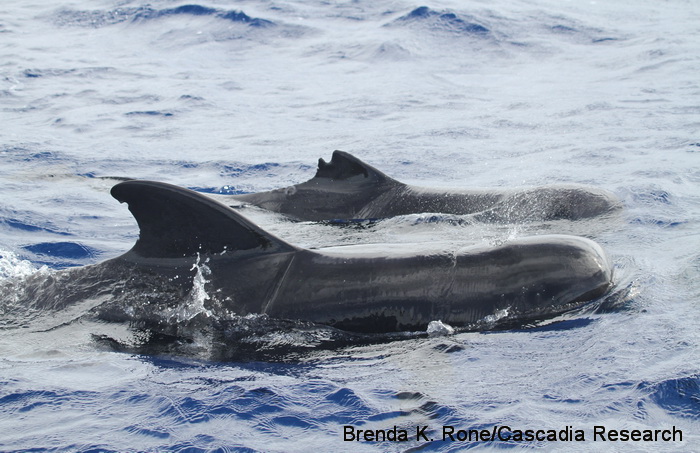
Short-finned pilot whale mother and calf, February 1, 2014. Photo by Brenda Rone.
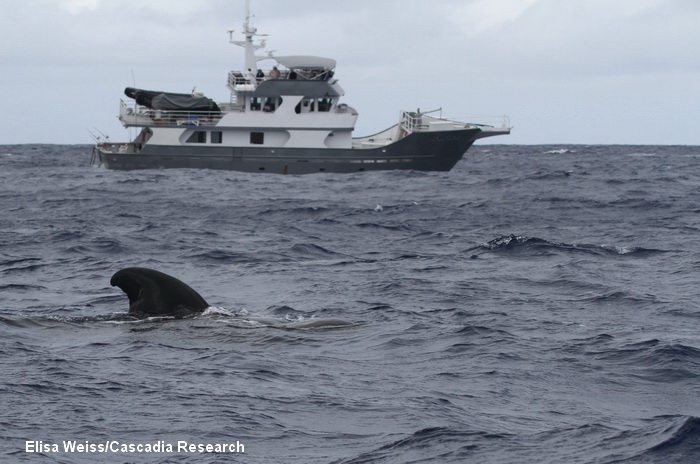
The R/V Searcher and a short-finned pilot whale, February 1, 2014. Photo by Elisa Weiss.
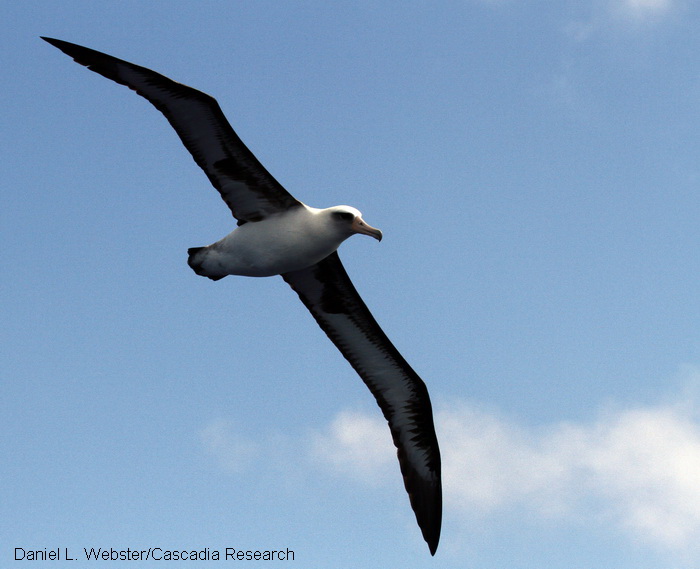
Laysan Albatross, February 1, 2014. Photo by Daniel Webster. We’ve also seen dozens of Laysan and Black-footed Albatross this trip.
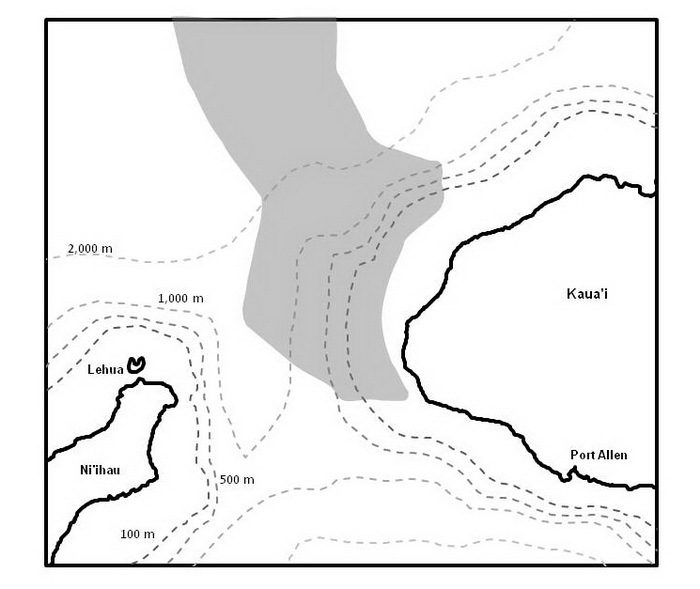
Our study area for the project. The Navy’s hydrophone range it shaded – approximately 175 hydrophones are spread across the shaded area connected to the M3R system.
Photos should not be used without permission. Contact Robin Baird (rwbaird (at) cascadiaresearch.org) for permission.
Sign up to our Facebook page if you want to receive notices of when information is posted and updates on other Cascadia projects.